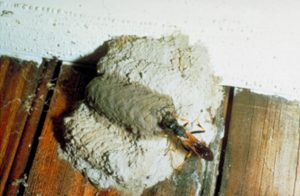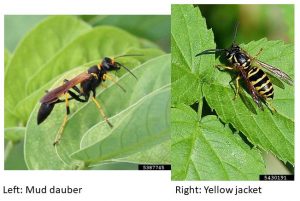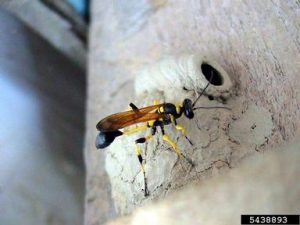Written by: Marge Vorndam, Colorado Master Gardener, 1997 Native Plant Master, 2007
Since I am allergic to Hymenopteran stings, living with wasps that don’t see me as a target for immediate attack are unique neighbors. There are wasps that can live with human neighbors and both reap the benefits of each other’s contribution to habitat without seeing the need to attack the other. Of course, a respectful distance is advised, as these well-armed native denizens are still able to take a toll if they are too closely approached and protecting their nests.
 When we acquired a home in a formerly dry rangeland, I decided to add a modest-sized wildlife pond. Little did I know that I was adding an entirely new ecological aspect to our home. Immediately, what I believe to be mud wasps showed up at the pond. They were using the water in combination with nearby soil to make their mud nests. Unfortunately, they chose my not-so-well-sealed potting shed as a nursery, so that became off-limits to me, or so I thought. However, they didn’t act like heat seeking missiles outside of that shed, which surprised us. The wasps looked very much like the aggressive yellow jackets but did not share the jackets’ proclivity for attack.
When we acquired a home in a formerly dry rangeland, I decided to add a modest-sized wildlife pond. Little did I know that I was adding an entirely new ecological aspect to our home. Immediately, what I believe to be mud wasps showed up at the pond. They were using the water in combination with nearby soil to make their mud nests. Unfortunately, they chose my not-so-well-sealed potting shed as a nursery, so that became off-limits to me, or so I thought. However, they didn’t act like heat seeking missiles outside of that shed, which surprised us. The wasps looked very much like the aggressive yellow jackets but did not share the jackets’ proclivity for attack.
 This hunting, thread-waisted wasp is the Black and Yellow Mud Dauber Wasp. Without close inspection, one might think that this wasp is its aggressive cousin, the Yellow Jacket. But in scientific parlay, the Mud Dauber belongs to Order Hymenoptera, Family Sphecidae with Scientific Epithet Sceliphron caementarium. The Yellow Jacket is in Family Vespidae, with many genii and species, and ten times the stinging venom power. The Mud Dauber’s body is elongated with a long narrow waist behind the thorax. Body color is black surrounded by yellow stripes around the body and on the legs. Adults are nectar-feeders.
This hunting, thread-waisted wasp is the Black and Yellow Mud Dauber Wasp. Without close inspection, one might think that this wasp is its aggressive cousin, the Yellow Jacket. But in scientific parlay, the Mud Dauber belongs to Order Hymenoptera, Family Sphecidae with Scientific Epithet Sceliphron caementarium. The Yellow Jacket is in Family Vespidae, with many genii and species, and ten times the stinging venom power. The Mud Dauber’s body is elongated with a long narrow waist behind the thorax. Body color is black surrounded by yellow stripes around the body and on the legs. Adults are nectar-feeders.
 The indication of the presence of this wasp is the development of the mud nest, generally found along the underside of building eaves. If you choose to dispense with the Mud Dauber as a neighbor, the time to do that is in winter to mid-Spring by simply destroying the mud nest. However, keep in mind that you will lose an aggressive arachnid (spider) controller. The Mud Dauber packs its nests with paralyzed but live spiders as food for its developing larvae which hatch into the adult stage in early Summer. Prey for the larvae of the Mud Dauber are typically orb-weavers, cat-faced spiders, crab spiders, wolf spiders and some use Black-Widow spiders. Of course, the spiders are beneficial removers of other insects such as house flies. Ecology is interwoven.
The indication of the presence of this wasp is the development of the mud nest, generally found along the underside of building eaves. If you choose to dispense with the Mud Dauber as a neighbor, the time to do that is in winter to mid-Spring by simply destroying the mud nest. However, keep in mind that you will lose an aggressive arachnid (spider) controller. The Mud Dauber packs its nests with paralyzed but live spiders as food for its developing larvae which hatch into the adult stage in early Summer. Prey for the larvae of the Mud Dauber are typically orb-weavers, cat-faced spiders, crab spiders, wolf spiders and some use Black-Widow spiders. Of course, the spiders are beneficial removers of other insects such as house flies. Ecology is interwoven.
As with all of nature, there are positives and negatives in living with other animal and plant species, but before you swat or spray this interesting denizen of our habitats, consider the place that they have in your environment. If they are of positive or neutral value, keep them around!
For further information, see
https://webdoc.agsci.colostate.edu/bspm/arthropodsofcolorado/Black-and-Yellow-Mud-Dauber.pdf
Thanks to Whitney Cranshaw for identification and information.


